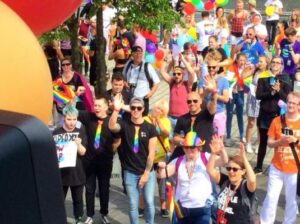Changing the fabric of society LGBTI-inclusive education

The announcement that the Time for Inclusive Education (TIE) Campaign has been successful in achieving LGBTI-inclusive education in all of Scotland’s state schools is not only monumental, but life-changing and potentially life-saving.
Having campaigned for this for three years now, our grassroots movement is set to change the way that young people are educated. The Scottish Government have accepted 33 recommendations that a national Working Group – established in response to our campaign – have proposed.
These recommendations include LGBTI inclusion across the curriculum, awareness training for teachers to facilitate delivery, and the specific recording of homophobic, biphobic, and transphobic bullying incidents. These proposals – the most comprehensive anywhere in the world – will make Scotland the standard bearer for LGBTI-inclusive education.
As the parent of a seven year old, I have been at the forefront of this movement alongside Jordan Daly. When I first met him and learned about his experiences, of struggling with suicidal thoughts as a young boy, I was moved to tears.
He was someone who felt lost, unable to be himself, unsure of his place within his school and his community. Why? Simply because he is gay.
When I first met him, my own child was three years old and all I could wonder was that if she grew up to be LGBT herself, was this situation acceptable for her? Clearly, the answer was no.
We then set out to change the world. It may sound ridiculous, but that was and still is our intention. In order to deliver social change, education is key.
I can say that because I was the perfect example of that myself. Prior to meeting Jordan, I never had any openly LGBT friends – indeed, I had existed in a completely heteronormative world.
As a parent, I was also unconsciously placing my daughter in each and every box that society had created for her. I would say things like: “How will you ever get a boyfriend or husband when you pick your nose?” or “Sophie from nursery can’t be your girlfriend, girls have boyfriends”.
I was completely unaware then, but I know now that I was putting my child into a closet and did not realise I was doing it. Jordan pointed it out to me, and my language and how I interacted with her changed instantly as I began to understand the impact of such stereotyping.
As our campaign took off, my daughter soon became aware that many of my new friends were LGBT. She was very comfortable and loved all of them. Indeed, I was proud of the way in which she was growing up. I was happy that I’d become aware of the fact that I had been enforcing stereotypes, and had reversed this trend before it could have an impact on her development.
Despite this, following her first year at school I noticed that she no longer wore our campaign’s t-shirt. It features a rainbow school tie, and had been specially made for her to wear whilst leading the Glasgow Pride Parade.
When I asked her why she replied, “if someone from school sees me wearing it they might think I am gay.”
How can this be the case? How can my six year old think that there is anything wrong with being gay – particularly when she knows, and loves, so many gay people?
It confirmed to me that there is a fundamental issue with the climate in our schools, even at this early age.
This is exactly why I am so passionate about LGBTI-inclusive education. We can attempt to eliminate bullying or prejudice before it arises with a fresh approach. An approach which fosters a culture of inclusion and raises awareness amongst young people of the diversity of our modern world.
Such an approach will ensure that all young people, and their families, are respected and included.
In Scotland, we are now on our way to fully implementing LGBTI-inclusive education. Young people – including my daughter – will learn about the LGBTI community and their history, and the impact that prejudice-based bullying can have on others.
In doing so, LGBTI young people can have a better experience at school, others can become more understanding and accepting of diversity, and we can move one step closer towards getting it right for every child.
We can change the fabric of our society with this educational approach. We can build a better future. Thanks to this commitment from the Scottish Government, we are in the early days of a better nation.
I would hope that what we have achieved in Scotland sends a message across Europe and the rest of the world. One that can inspire others to make the case for LGBTI inclusion for future generations of young people.
A blog by Liam Stevenson
Find out more about TIE here: https://www.tiecampaign.co.uk/
